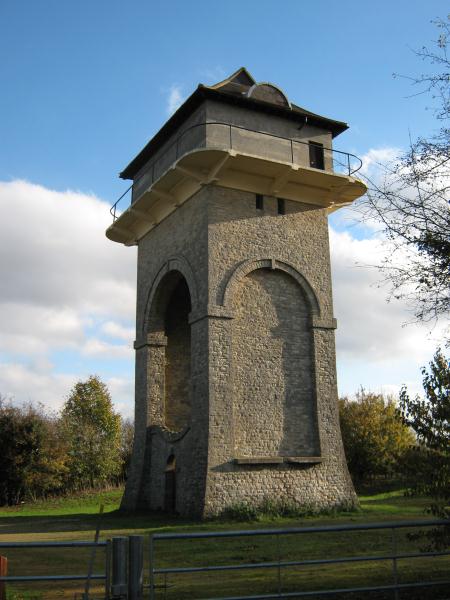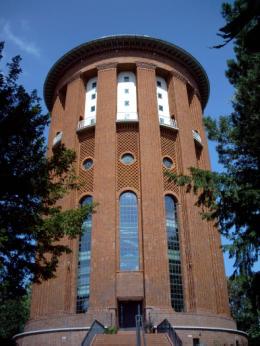 Swifts
used to nest in woodpecker holes in the massive trees found in ancient forests.
Nowadays they will sometimes breed in structures Swifts
used to nest in woodpecker holes in the massive trees found in ancient forests.
Nowadays they will sometimes breed in structures
like old fortifications and water towers, if they can find a space in
them to make a nest. So why not create a special nest
colony in a similar structure?
| A
good site for a discreet nestbox project
Below, an interesting early 20th Century water
tower in Berlin. This was fitted some years
ago with Swift nest boxes,
and for some time the colony did well. But in
recent years Swifts have failed
to breed there. No one knows why, as they are still present in the
sky above the neighbouring apartment blocks.
On
this tower, for architectural and aesthetic
reasons, the nest boxes were bespoke, mounted
internally and made from plywood.
At less
sensitive sites, like modern concrete water
towers, commercial readymade concrete
or GRP nest boxes may be used with great ease and
economy.
It is always worth fitting
Swift nest boxes to such sites, as they
have several important advantages; longevity,
security, centralised management, privacy, opportunites for observation
and CCTV/web cam installation, excellent
possibilites for educational activities
involving residents and local schoolchildren
and of course, good publicity for the utility
company involved.
Photo
© Edward Mayer
|
Another
good site for a project?
Below,
an
historic water tower near Cherwell in Oxfordshire, easily
visible from the motorway.
Such a site could be just right for Swifts,
as commercially available nestboxes might
be fitted easily and fairly unobtrusively
under the balcony, where they would be in the perfect position to host Swifts.
Photo
© Chris Mason

|
 The
minimum height
for a Tower colony is 7 metres, but the higher
the better, and the safer. The site must not be vulnerable to vandalism. The
minimum height
for a Tower colony is 7 metres, but the higher
the better, and the safer. The site must not be vulnerable to vandalism.
A concentration
of birds may present an attractive target for anti-social
behaviour. Nest places should therefore be sited as
high as possible and at sites
which are either unattractive
to vandals or else secure. Industrial estates, electrical
switching yards, warehousing sites, nuclear and other power
stations, hospitals, railway sidings,
factory towers and chimneys all present potential opportunities
for siting tower colonies, while vandalism-prone housing
estates and unsecured sites in general
should probably be avoided.
 N.B. It is essential to have an engineer check the site and plans
for any proposed Swift Tower for structural
soundness well before any work starts.
N.B. It is essential to have an engineer check the site and plans
for any proposed Swift Tower for structural
soundness well before any work starts.
 Back to Fitting Swift Nest Places
Back to Fitting Swift Nest Places
 Need advice? Consult us!
Need advice? Consult us!
 Back to Contents Back to Contents
|
 Swift
Towers
Swift
Towers

